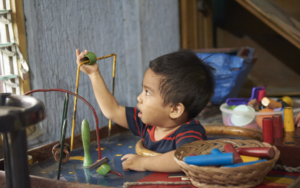How to Take Care of a Child Who is Too Shy: Expert-Backed Tips
Is your child extremely shy? Discover how to nurture a shy child and build his confidence and social skills naturally.
“Shyness is not a weakness, but a silent strength that can shine with the right support!”
Does your child go silent in the presence of others or get uncomfortable in a new setting? There are a lot of children who are shy by nature, and that is perfectly okay! It is said that around 15% of children are born with a shy nature.
But a difference does lie between shyness and social anxiety. In this article, we will discover how to care for shy children without pressuring them. You will receive practical tips for parenting, expert guidance, and all that will make your shy child a confident person.
Then let’s start on a loving and supportive path, where you will bring out the best in your child by embracing him for his personality!
Understanding Shyness in Children 
Every child is unique—some kids are outgoing and fearless, whereas others are shy by nature or a little reserved. Shyness does not necessarily mean that the child lacks confidence, but it may be a part of temperament, too. Let us learn why kids are shy and whether it is normal or if we need to consult a professional.
1. What makes a child shy: Temperament or Environment
There can be two possible reasons for shyness:
Temperament (naturally): Certain children are naturally a bit timid and reserved. This is part of their natural genetic makeup, which determines their behavior.
Environment: If the child is being raised in an environment where little interaction is taking place, or where there are stressful or critical situations, then shyness can also arise.
Both these conditions combined can result in shyness. So, it is essential that parents know their child’s temperament and make adjustments in the environment accordingly.
2. How is shyness different from introversion and anxiety
Most people think of shyness, introversion, and anxiety as the same, but these three are distinct:
Shyness: When the child is a bit shy in the presence of new individuals or situations. But with encouragement, they gradually adapt.
Introversion: Introverted children are not social; they prefer to be alone or with one or two close friends. But they are not nervous.
Anxiety: When a child is nervous around other people or has physical symptoms like stomachaches or nausea, it might be social anxiety.
It is significant to note that shyness is a typical behavior, but when overdone, it turns into anxiety.
3. Stages of development and when it is normal to be shy
The manifestation of shyness varies for every age group:
1-3 years: Toddlers tend to be clingy or cry at the presence of new people. This is normal.
4-6 years: Preschoolers may be shy when they have to meet new school or friends. But this phase is usually temporary.
7+ years: If the child still feels very shy at this age and does not interact with others, parents should observe closely.
The Do’s and Don’ts of Parenting a Shy Child
1. Never call your child “shy” in public
If you persistently introduce your child to everyone with the words “he is shy“, you are inadvertently linking his identity to that term. Children begin identifying with that word as theirs, and their level of confidence drops even further. Instead, emphasize other positives of their personality, such as “he is reflective” or “he is perceptive”.
2. Support them gently, never push them
Forcing the shy child to attend a party in front of everybody makes him more fearful. This stresses him out even more. Encourage him softly in little circumstances, such as introducing him to a few people or letting him know beforehand who he will be meeting. Soft encouragement allows the child to develop at his own pace.
3. Honour their boundaries, but gradually build out their comfort zone
Sir, kids are not always at ease with strangers. It is very essential to respect their personal space and comfort zone. However, it does not imply that they always remain in the same zone. You can give them safe and supportive environments to bring them out of their comfort zone, such as remaining for 30 minutes at a close friend’s birthday party.
4. Celebrate small victories or efforts
If your child answers a question from a new child or responds to a teacher’s query, be thankful—no matter how small the step may be. Positive reinforcement assures them that they are doing something of value. This builds their self-confidence.
Creating a Safe and Supportive Environment at Home 
For kids, home is their initial school. If your kid is shy, then it is extremely necessary to provide a safe and supportive home to him/her initially. Let us learn how:
1. How the dynamics of home affect a shy child
The environment of the home directly influences the behavior of a shy kid. If there are greater teeth, loud voices, or comparisons within the home, then shy kids get more secluded.
-A serene and tolerant atmosphere provides shy children with a sense of emotional security.
-When parents remain calm and patient, the child begins expressing his/her views on his/her own.
-Each child possesses his temperament; thus, respecting and understanding them is a must.
2. Modeling confident communication
Children learn from their parents. If you communicate confidently, your shy child will imitate you slowly.
-Model polite and respectful communication, such as making eye contact, smiling, and talking softly.
-When greeting someone, include the child as well – “Son, greet Aunty.”
–Don’t use negative self-statements, such as “I cannot speak to people” – your confidence will be an example to them.
3. Giving room for expression without forcing
Bullying shy children too much may heighten their level of anxiety. Provide them with opportunities to express themselves at their own pace.
–Don’t push them to perform in public until they’re ready.
-Praise them for small successes, such as making eye contact with someone or smiling and saying hello softly.
–Listen carefully to their ideas and feelings without interrupting them – this increases their confidence.
4. Building confidence through books, toys, and role-play
Play with children reduces their shyness. Storytime and role-play are safe practice areas for shy children.
-Read them books with shy characters – such as “Willow the Quiet” or “Shy Charles“ – so the child can identify with it.
-Allow them to play doctor-patient, teacher-student in role-plays – this develops their social skills.
-Have them converse through the use of puppets, stuffed animals – it’s an unthreatening way to gain confidence.
Helping Your Child in Social Situations
Encouraging a shy or very introverted child to feel at ease in social settings could be a bit tricky. But with some preparation and positive reinforcement, you can slowly build your confidence in the child. Below are some hands-on tips that can be helpful to you:
1. Prepare them in advance for parties and gatherings
Whenever there is a birthday party, school event, or family reunion, inform the child in advance. Inform them who will be present, what will happen, and what to expect. When the child is prepared in his mind, his anxiety level comes down. You can even make them repeat some statements or activities like – “If aunty tells you how are you? Then what would you reply?”
2. Role-Playing and Social Scripts
It is simple to educate the child on how to respond in actual situations if you role-play with the child. For instance, play at home – the child welcomes a guest. Social scripts refer to some simple sentences or reactions that the child can apply in various situations, such as:
“Hello, my name is Aarav.”
“May I also play?”
“Thank you!”
With such role-playing, the child gains confidence and starts developing an understanding of social cues.
3. Social Skills Teaching: Greetings, Eye Contact, and Asking
Teach the child little things such as greeting someone by saying “Hi” or “Namaste”, eye-to-eye contact, and asking politely – “What is your name?”, “What are you playing?”
With these rudimentary social skills, the shy child slowly steps out of his comfort zone and learns to communicate with others.
4. Help them make one-on-one friendships, rather than push them into groups
Shy children feel nervous in front of many people. So, put them in small social environments, such as arranging a playdate with a friend. They form their trust through one-on-one interactions and openly show their emotions. When their bonding is strong, they slowly begin to feel comfortable in groups, too.
Working with Teachers and Schools
When your child is a bit reserved, the school atmosphere will prove to be challenging for them. It is for this reason that it is highly essential for parents to coordinate with teachers. Let us see how you can boost the confidence of your child by coordinating with the school and teachers.
1. Encourage the child by collaborating with teachers
To begin with, you need to keep regular and sincere contact with your child’s teachers. Inform them about your child being shy and what works best for him.
-Find out from them how they are monitoring their child’s behavior in the classroom
-Discuss guidelines on strategies you employ in the home setting
-Build a good support relationship so that teachers can give one-to-one attention
2. If necessary, create an Individualised Support Plan
If your child is extremely shy and their shyness is impacting their learning and engagement, you can cooperate with the school to create an Individualised Support Plan (ISP).
-The plan can incorporate the following:
-More time for social interaction
-A place of safety where the child can unwind
-Regular one-to-one interaction with a teacher or counselor
-Step-by-step exposure to group work
The plan addresses the child in growing at his own pace without any pressure.
3. Invite participation, but without singling out
If the kids are suddenly called before the whole group, they become even more apprehensive. So, invite them to participate, but without spotlighting them.
-Ask teachers to include them in group work in a low-key manner
-Begin by asking them to perform minor tasks such as paying attention or writing on the blackboard
-When they cooperate, quietly commend them
This increases their confidence discreetly, without embarrassment.
4. School activities that enable shy children to break their shells
Each school has a lot of such activities that are beneficial for shy children – you just need to select a few carefully.
-Expressive activities like art & crafts or creative writing
-Supportive roles in the drama club where they can work behind the curtain
-Reading circles or buddy systems where they talk to a close friend
-Group work where they can participate at their speed
These tasks enable the shy kids to move out of their comfort zone without any pressure.
Conclusion
Shyness isn’t something that needs to be “fixed”—it needs to be understood. With the right support, shy children can become emotionally intelligent, thoughtful leaders. From creating a nurturing home environment to partnering with teachers and even professionals when needed, you now have a roadmap to help your child blossom confidently at their own pace.
Remember: Patience, empathy, and encouragement go a long way. Let your child know it’s okay to be quiet—and powerful.

